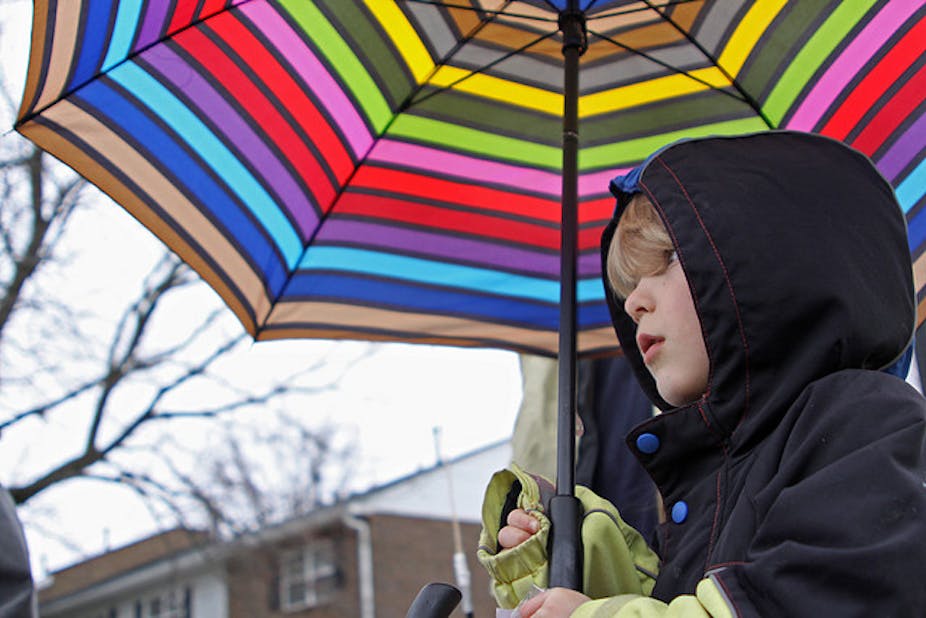It’s often suggested that children with same-sex parents have poorer outcomes because they’re missing a parent of a particular sex. But research my colleagues and I published in the journal BMC Public Health shows this isn’t the case.
In fact, we found children in same-sex families scored better on a number of key measures of physical health and social well-being than kids from the general population.
But stigma is a common problem. Around two-thirds of children with same-sex parents experienced some form of stigma due to their parents’ sexual orientation which, of course, impacts on their mental and emotional well-being.
Our method
Research in this area has traditionally focused on lesbian parents and used small sample sizes. So we surveyed 315 same-sex attracted parents with a total of 500 children, aged up to 17 years, across Australia.
These children are growing up in a range of family contexts formed in a range of ways; from previous heterosexual relationships, to assisted reproductive technologies and same-sex co-parenting arrangements. Around 80% had female parents and 18% had male parents.
We asked the parents to answer a range of questions on health and well-being using internationally recognised measures. This produced a set of scores that represent overall child health.
Parent reports are necessary to determine how young children are faring. While parents don’t always view health experiences in the same way as their children, there is no evidence to suggest that any group of parents systematically overstate child well-being in population research.
We compared the responses from the same-sex parents in our study to established population samples. This allowed us to interpret our findings against population norms.
What we found
Our results suggest children with same-sex attracted parents are doing well in terms of their overall health and that their families are getting along really well.
We found that children from same-sex families scored, on average, 6% better on two key measures, general health and family cohesion, even when controlling for a number sociodemographic factors such as parent education and household income. But on most health measures, including emotional behaviour and physical functioning, there was no difference when compared with children from the general population.
In spite of doing well, many children did experience stigma, which was linked to lower scores on a number of scales. Stigma can be subtle, such as letters home from school addressed to Mr and Mrs. Or it can be overt and very harmful, in the form of bullying and abuse at school. The more stigma the family experienced, the greater the impact on the social and emotional well-being of the children.
Our findings support and strengthen the existing international research undertaken with smaller sample sizes.

Interestingly, there is growing evidence to suggest that the structure of same-sex parent families, particularly in relation to work and home duties, plays an important part in how well families get along. Same-sex parents, for instance, are more likely to share child care and work responsibilities more equitably than heterosexual-parent families.
It is liberating for parents to take on roles that suit their skills rather than defaulting to gender stereotypes, where mum is the primary care giver and dad the primary breadwinner. Our research suggests that abandoning such gender stereotypes might be beneficial to child health.
Politicising same-sex families
A little more than two years ago Doctor’s for the Family created headlines by suggesting that:
the evidence is clear that children who grow up in a family with a mother and a father do better in all parameters than children without.
This claim was prompted by a senate inquiry into marriage equality. Over the subsequent months, discussions about the place of children in same-sex families have continued, with remarkable comments coming from many corners arguing that same-sex attracted people are not fit to raise children.
Senator Ron Boswell asked, “who takes the boy to football? Who tells him what’s right from wrong?” Senator Cory Bernardi compared homosexuality to bestiality. And although the ACT tried to legislate for marriage equality, the federal government struck down those laws on the grounds that they were constitutionally invalid.
Now this conversation continues. Adoption laws across Australia are inconsistent, with states such as New South Wales and Western Australia allowing same-sex adoption.
The issue of adoption has risen to the fore in Victoria as we move towards a state election. Current state legislation does not allow same-sex couples to access adoption and as a result many same-sex families live with a degree of insecurity over parenting rights. This particularly affects those with long-term foster children or those born through surrogacy.
In the lead-up to Victoria’s November election, the Victorian Labor Party is ready to support adoption reform. The state Liberal Party is yet to commit either way but has left it to backbencher Clem Newton-Brown to consider the issue as he fights to hold onto his gay and lesbian friendly seat of Prahran.
As we move into a fresh round of debates on the suitability of same-sex attracted people to be parents, it’s important that we remember that the words of politicians can have a detrimental impact on the 33,000-plus same-sex families in Australia.
But in the face of a number of such barriers, including stigma and legislated discrimination, children with same-sex parents appear to be doing well. Instead of criticising these loving family units perhaps it is time to see what we can learn from them – for the benefit of all our children.

